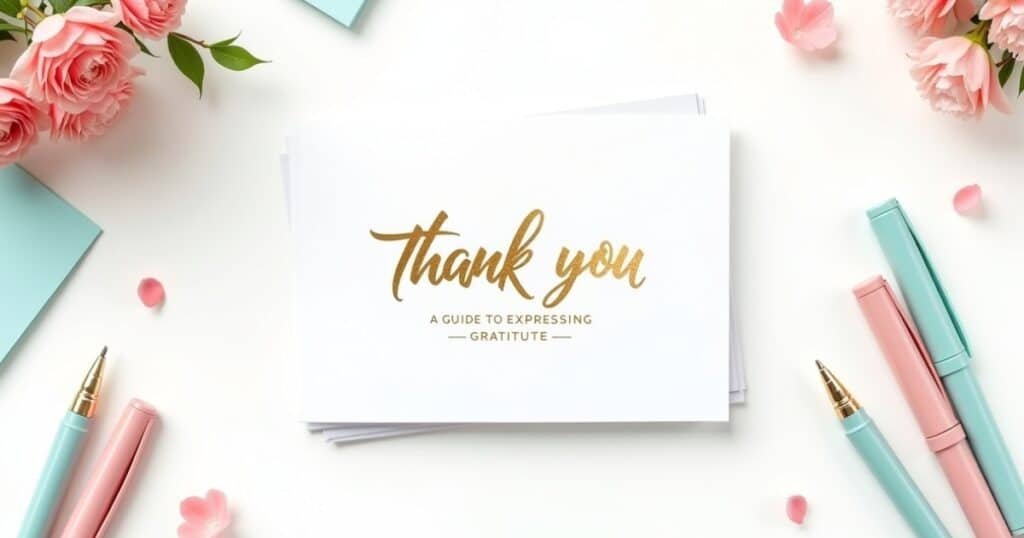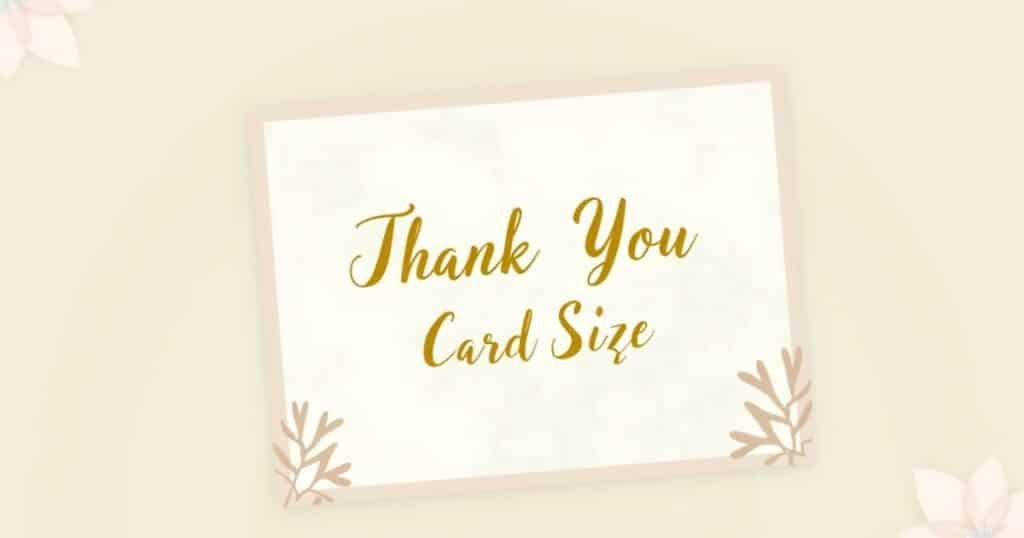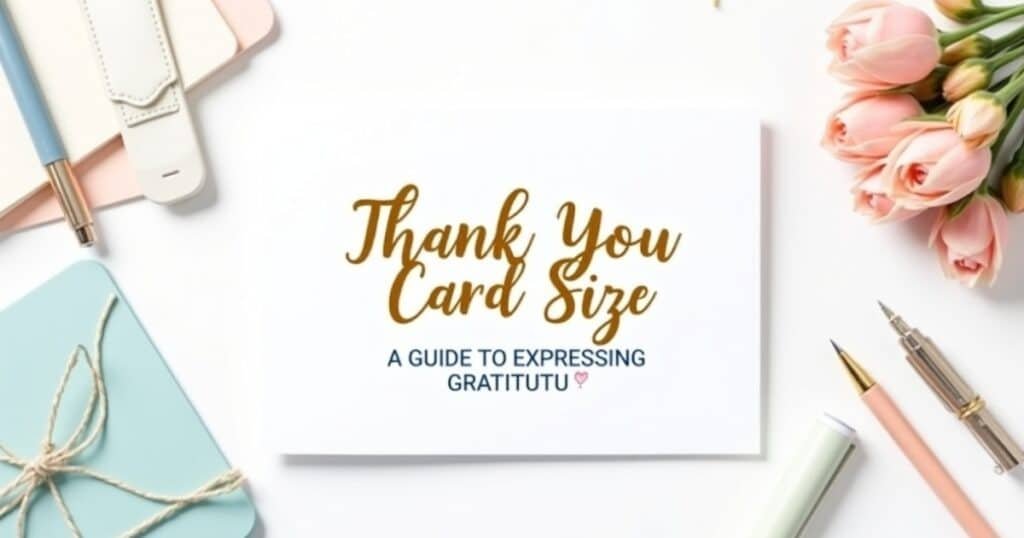Have you ever stood in the stationery aisle, overwhelmed by the array of thank you cards in different sizes and shapes? Or maybe you’ve received a heartfelt note that was perfectly sized not too small to feel insignificant, not too large to seem excessive?
The size of a thank you card might seem like a minor detail, but it actually speaks volumes about the occasion, your relationship with the recipient, and even the cultural context of your gratitude.
In today’s digital age, when a text message or email can be sent in seconds, the physical thank you card has taken on renewed significance.
It’s a tangible token of appreciation that someone can hold in their hands a physical reminder of your gratitude that can be displayed or treasured. And understanding the various sizes available helps you choose the perfect canvas for your message of thanks.
How Large Are Standard Thank You Cards?
Standard thank you cards typically measure 4.25 x 5.5 inches (A2 size) when folded about the size of your palm or a smartphone. This versatile size fits comfortably in most envelopes, displays nicely on a desk or shelf, and provides enough space for a personal message without feeling overwhelming.
You’ll encounter this familiar size everywhere from wedding thank yous to business appreciation notes, making it the go-to choice for expressing gratitude in most situations.
Standard Thank You Card Sizes
A2 Cards (4.25 x 5.5 inches)
The A2 card represents the quintessential thank you note size in American stationery. Its humble dimensions create the perfect balance intimate enough to feel personal, yet substantial enough to convey respect and significance.
Most mass-produced thank you cards come in this size because it strikes an ideal balance between economy and impact. The A2 provides approximately 23 square inches of interior space for your message enough for several heartfelt sentences without requiring a novella.
The envelope for an A2 card typically measures 4.375 x 5.75 inches, allowing for easy insertion while maintaining a professional appearance. The A2’s popularity extends beyond thank you notes to invitations and announcements, making it a true workhorse in the stationery world.
Did you know? The “A” in A2 doesn’t refer to a paper quality, but rather to the corresponding envelope style. The number indicates the card size within that envelope family.
A6 Cards (4.5 x 6.25 inches)
When your gratitude requires a bit more space, the A6 card offers a slightly larger canvas. This size provides approximately 28 square inches of interior writing space about 20% more than its A2 cousin.
The A6 size has become increasingly popular for wedding thank you cards, where couples often include small photos or need extra room to thank guests for specific gifts. The additional space allows for a more detailed message while still fitting neatly into a standard envelope (4.75 x 6.5 inches).
Business professionals often choose A6 cards when sending thanks to clients or partners, as the slightly larger format conveys a sense of importance without seeming extravagant.
Interesting fact: While A6 cards have grown in popularity in North America, they’ve long been a standard in European stationery, where the ISO 216 standard defines different paper sizes than the American system.
5 x 7 Inch Cards
The 5 x 7 inch thank you card represents a step up in formality and significance. With 35 square inches of interior space, these cards provide ample room for longer messages, corporate logos, or decorative elements.
Often used for professional thank you notes, client appreciation, or following significant events like weddings or fundraisers, the 5 x 7 card makes a statement. The substantial feel in the recipient’s hands communicates that your gratitude is equally substantial.
The corresponding envelope typically measures 5.25 x 7.25 inches, and often features a pointed flap rather than the rounded flap common to smaller card envelopes another subtle indicator of formality.
Did you know? The 5 x 7 inch size corresponds closely to the international A7 size (4.96 x 7.09 inches), making it one of the few card formats that translates well between American and international stationery systems.
Note Cards (4.25 x 5.5 or 4.5 x 6.25 inches folded)
Note cards represent a versatile category that includes both A2 and A6 sizes. What distinguishes a note card from other thank you formats is its typically plain or minimalist design, often featuring just a monogram, simple graphic, or border.
These understated cards provide a clean canvas for your message of thanks, letting your words take center stage rather than competing with elaborate designs. Many professionals and families keep a supply of personalized note cards on hand for various correspondence needs, including thank you messages.
Quality note cards are frequently made from heavier stock (typically 80-110 lb) than mass-produced thank you cards, giving them a premium feel that elevates your message of appreciation.
Fun fact: Personalized note cards were once considered essential for any socially active adult. Emily Post, the famous etiquette expert, recommended that young adults receive their first set of personalized stationery as a high school graduation gift.
Postcards (4 x 6 inches)
For casual thanks or situations where brevity is appropriate, the thank you postcard offers an economical and environmentally-friendly alternative to folded cards. Most thank you postcards measure 4 x 6 inches large enough to accommodate a short message while qualifying for standard postcard postage rates.
The postcard format has enjoyed a resurgence in recent years, particularly for business thank yous where a brief acknowledgment is sufficient, or for casual personal thanks. Without an envelope, postcards create less waste and allow for creative designs on both sides.
Modern thank you postcards often feature colorful photographs or striking graphics on the front, with space for a handwritten message and address on the back. This format works particularly well for thanking multiple people after events like birthdays or baby showers.
Interesting tidbit: The U.S. Postal Service has specific requirements for postcards to qualify for the lower postcard rate: they must be rectangular, at least 3.5 × 5 inches, no more than 4.25 × 6 inches, and have a thickness between 0.007 and 0.016 inches.

Non-Standard Thank You Card Sizes
Mini Cards (2.5 x 3.5 inches)
These petite expressions of gratitude pack a surprising punch. At roughly the size of a business card, mini thank you cards have gained popularity for their charm and novelty.
Mini cards work beautifully for accompanying gifts, thanking wedding guests for small favors, or expressing quick appreciation to colleagues or service providers. Their diminutive size creates an intimate feeling like a secret message shared between friends.
Despite their small stature, these cards rarely go unnoticed. Their unexpectedness often makes them more memorable than their larger counterparts. They typically come with appropriately sized envelopes measuring about 2.75 x 3.75 inches.
Fun fact: Mini cards share dimensions with artist trading cards (ATCs), a popular format for artists to exchange small original works, making them collectors’ items in certain circles.
Square Cards (5 x 5 or 6 x 6 inches)
Breaking away from rectangular tradition, square thank you cards offer a contemporary aesthetic that immediately distinguishes your gratitude. Popular sizes include 5 x 5 inches and 6 x 6 inches, though custom dimensions are increasingly available.
The symmetrical shape creates a modern, design-forward impression, making square cards particularly popular for thanking clients in creative industries or for personal thanks after milestone celebrations.
It’s worth noting that square envelopes may require additional postage when mailed, as the U.S. Postal Service charges a non-machinable surcharge for square formats. However, many senders consider this extra cost worthwhile for the distinctive presentation.
Did you know? Square formats have grown in popularity alongside social media platforms like Instagram, where square images became the standard format. This visual familiarity has helped square cards feel both fresh and familiar simultaneously.
See Also: Samsonite Suitcase Sizes: A Complete Guide
Oversized Cards (5.5 x 8.5 inches or larger)
When ordinary gratitude won’t suffice, oversized thank you cards make a dramatic statement. These substantial cards, often measuring 5.5 x 8.5 inches (half of a standard letter sheet) or larger, provide abundant space for detailed messages, multiple signatures, or decorative elements.
Businesses often use oversized cards for client appreciation, especially when multiple team members wish to add personal notes. They’re also popular for group thanks, such as a classroom thanking a guest speaker or a team thanking a departing colleague.
The physical presence of a large thank you card makes it difficult to overlook or dismiss it literally takes up space in the recipient’s environment, much like your gratitude occupies mental space.
Interesting fact: Some oversized thank you cards are designed to double as keepsakes or photo frames, extending their usefulness beyond the initial expression of gratitude.
Folded vs. Flat Cards
Beyond specific dimensions, thank you cards can be categorized as either folded or flat. Folded cards offer the traditional greeting card experience an exterior that reveals an interior message when opened. This format creates a moment of discovery and provides separate spaces for a brief greeting and a more detailed message.
Flat cards, by contrast, utilize a single surface for both design elements and the written message. They offer a more modern, streamlined appearance and can be more economical and environmentally friendly, using less paper and smaller envelopes.
Each style has its appropriate applications. Folded cards typically convey more formality and personal investment, while flat cards project contemporary efficiency. Your choice between them should reflect both the occasion and your relationship with the recipient.

Special Formats and Applications
Photo Thank You Cards
The integration of personal photography has revolutionized the thank you card market. Photo thank you cards, which incorporate one or more photographs into their design, have become especially popular for weddings, baby showers, and milestone birthdays.
Standard photo thank you cards typically conform to conventional sizes like 4 x 6 inches or 5 x 7 inches, but fold-out designs may create larger surfaces when opened. Some popular formats include:
- Single-photo cards with the image on one side and message on the reverse
- Folded cards with a photo on the cover and message inside
- Multi-panel cards that showcase several images alongside the thank you message
The personalization offered by photo cards creates an immediate emotional connection with the recipient, who sees familiar faces before even reading the message of gratitude.
Did you know? Modern digital printing has made photo thank you cards accessible to everyone, but the concept dates back to the Victorian era when wealthy families would sometimes include small daguerreotype photographs with their correspondence.
Digital Thank You Cards
While physical cards remain the gold standard for sincere gratitude, digital thank you cards have carved out their niche in today’s fast-paced world. These electronic expressions of thanks don’t have physical dimensions in the traditional sense, but they typically conform to standard screen proportions to ensure proper display.
Common digital card dimensions include:
- 1920 x 1080 pixels (16:9 aspect ratio) for viewing on most modern screens
- 1080 x 1080 pixels (1:1 aspect ratio) for social media sharing
- 600 x 800 pixels for email-optimized designs
Digital thank you cards offer advantages in speed, cost, and environmental impact. They’re particularly appropriate for business contexts, casual relationships, or situations where geographical distance makes physical cards impractical.
Interesting tidbit: Some digital thank you card services now offer analytics, allowing senders to see when recipients open their cards bringing modern metrics to the age-old practice of expressing gratitude.
Choosing the Right Size for Your Thank You Card
Consider the Occasion
The significance of the occasion should inform your choice of card size:
- Weddings and major life events typically warrant larger formats (A6 or 5 x 7) that provide space for detailed, personalized messages.
- Business thanks might use standard A2 sizes for routine appreciation, reserving larger formats for significant client milestones.
- Casual thanks between friends or for small favors can work beautifully with smaller formats or postcards.
See Also: Samsonite Suitcase Sizes: A Complete Guide
Think About Your Message Length
Before selecting a card size, consider how much you plan to write:
- A brief “thank you for the lovely dinner” requires minimal space and might work well on a smaller card or postcard.
- Thanking someone for significant support during a difficult time might require more room for expressing the depth of your gratitude.
- Group thanks, where multiple people will sign, naturally require larger formats.
Factor in Mailing Considerations
Practical considerations matter when choosing thank you card sizes:
- Standard A2 and A6 cards mail with regular first-class postage in the US.
- Square, oversized, or unusually shaped cards often require additional postage.
- If sending internationally, consider that postal requirements vary by country.
Practical Measurement Tips
Visualizing Thank You Card Sizes
If you’re shopping online and struggling to visualize different card sizes:
- A2 (4.25 x 5.5 inches) is about the size of a smartphone or standard index card
- A6 (4.5 x 6.25 inches) approximates the size of a photograph
- 5 x 7 inch cards are similar to a medium-sized paperback book cover
Creating Your Own Thank You Cards
For DIY enthusiasts, understanding standard sizes helps with crafting homemade cards:
- Standard letter paper (8.5 x 11 inches) can be folded in half to create 5.5 x 8.5 inch cards
- Quarter-folding letter paper produces cards approximately A6 sized
- For A2 sized cards, start with paper that’s 8.5 x 5.5 inches and fold once
When making your own cards, remember to factor in envelope availability custom-sized cards might require custom envelopes as well.
Conclusion
While thank you cards come in various sizes and formats, the true measure of gratitude lies not in the dimensions of the card but in the sincerity of the message it contains. That said, choosing the appropriate size for your thank you card demonstrates thoughtfulness it shows you’ve considered both practical needs (like message length) and social conventions.
Whether you opt for a tiny note card that fits in the palm of your hand or an oversized statement piece, your choice becomes part of the message itself. In selecting the perfect canvas for your words of appreciation, you add another layer of meaning to your thanks.
Look around your home how many different thank you card sizes can you find? Perhaps there’s an assortment tucked away in a drawer, waiting to be pressed into service the next time someone deserves your written gratitude.
In our increasingly digital world, the physical thank you card whatever its size remains one of the most meaningful ways to acknowledge the kindness of others.
Read more knowledgeable blogs on Measure Take.



